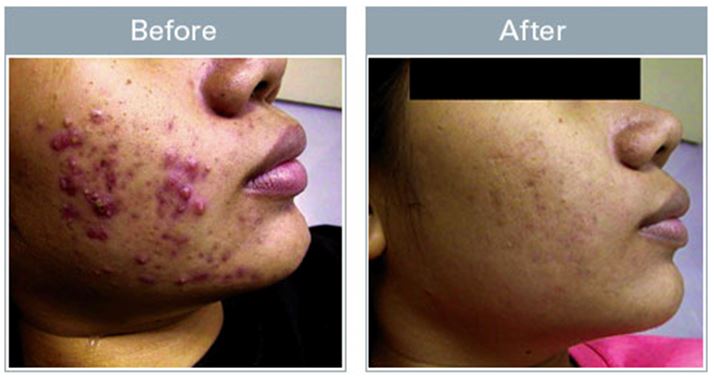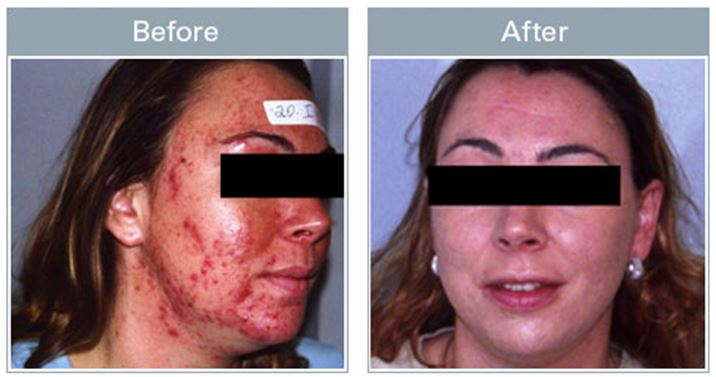Marcea Wiggins, ND
Acne vulgaris is a proliferative and difficult-to-treat condition that affects millions of teenagers and adults alike. Naturopathic medicine offers patients a deeper perspective into their condition and addresses the underlying causes, which in the case of acne vulgaris can include imbalances in hormones, the gut biome, inflammation, and digestion. With a thorough investigation into the root causes, we can effectively address the internal aspects of acne. Ultimately, the impact of the internal imbalances express on the dermis. In this article, we will focus on the use of today’s current technology that can address the rehabilitation of the dermis to a healthy, intact state. With the use of Photo Dynamic Therapy (PDT) and varying wavelengths of ultraviolet (UV) light, heat, and energy that stimulate the body’s inherent healing mechanisms, this technology easily fits into our philosophy and scope of practice as naturopathic doctors. Most importantly, it provides patients access to highly effective and comparatively fast-resolution treatment options for addressing what can be – while not life-threatening – a detrimental condition that can profoundly affect quality of life.
Phototherapy for Acne Vulgaris
Phototherapy has long been an FDA-approved effective intervention for acne vulgaris. It provides the patient with an efficacious and viable treatment option that addresses the problem at the site of the dermis, and without the negative effects (and sometimes far less optimal results) associated with standard systemic medications such as birth control pills, oral antibiotics, and retinoids such as isotretinoin. This combination of wavelengths of light and thermal effects on tissue is highly effective at stimulating the body’s inherent repair and remodeling mechanisms.1
Intense Pulsed Light & LHE
Intense Pulsed Light (IPL) is full-spectrum UV light that is filtered to allow selected wavelengths that address specific targets in the dermis. The most effective IPL treatments offer these multiple wavelengths for maximum results.2 Another element is the utilization of LHE (light, heat, energy technology), a form of IPL that includes a burst of heat with the delivery of the pulse.
For the purposes of acne reduction, there are multiple wavelengths of light that convey benefit. The most effective wavelengths for creating a bacteriostatic effect on the tissue run in the 400-500 nm wavelength. At this level, the light attaches to the porphyrins produced by the Propionibacterium acnes bacterium, thereby causing photoexcitation and the release of singlet oxygen, which in turn destroys the bacteria.3,4 If the bacteria are resistant, a culture is useful in order to see if the organisms are predominantly Staphyloccoccus aureus, a bacterium that will not respond to this wavelength.
Additionally, wavelengths above this spectrum, up to near infrared range (>600 nm), will attach to the hemoglobin existing in the surrounding capillaries of an affected pore. Once the heme is exposed to this wavelength, it coagulates, blocking the blood supply to these hyperactive and obstructed sebaceous glands. The shorter wavelengths impact the more superficial vessels, while the longer wavelengths impact the deeper vessels, providing a reduction of the erythemic appearance.5
The final component of the most effective IPL for acne includes a burst of heat, or light, heat, and energy (LHE).3,6 Many IPL units today have cooling mechanisms upon delivery in order to support the patient’s experience during the treatment. However, in the case of acne reduction, the little burst of heat is essential to the process for a few reasons. The benefit of therapeutic heat on microorganism-induced diseases of the skin has been established for decades. By thermally altering the sebaceous gland – the site where acne lesions begin – the root of the problem can be addressed. The thermal impact on the pore itself includes a softening and opening of the tissue, which allows excess sebum to be released.

Post-IPL Treatment
After the last IPL treatment (2 treatments per week for 4 weeks), it is important to note that removal of the hyperkeratinization around the pore is another piece that must be addressed. This is because this layer of dead cells can cause blockage in the future. This can be achieved through microdermabrasion, derma-filing, and medical-grade chemical peels. Once the IPL treatment series have concluded, a series of these treatments should be done in order to clear the cells, leaving the most healthy, collagen-rich tissue possible. At this juncture, the appropriate daily skincare regimen, customized to each patient’s skin type, should be in place.
Resurfacing
Once the patient’s internal issues contributing to acne have been addressed and he or she is on the appropriate daily topical regimens, LHE technology is utilized, which clears the patient’s skin of lesions within 1-2 months. Following this, we can then explore options for resurfacing the dermis that can dramatically diminish the appearance of hyperpigmentation and scarring from previous lesions. Doing so can leave the skin with very little trace of the previous condition, and can be life-changing for many.
Some of the most effective current options for resurfacing include erbium ablative and non-ablative fractional laser or CO2 laser, which targets the water in the cells to break down the tissue for collagen remodeling; also the newest resurfacing technology, which uses a high-intensity, focused micro-needle radio-frequency (RF).7 For acne scarring, most of these methods require 3-6 treatments, depending on the severity. All resurfacing technologies appear to be highly effective; it is up to the doctor and patient to determine which one is the best fit for the individual, based on their ability to have downtime and an understanding of the procedure. With any of these technologies, the goal is to remodel the collagen, which means disrupting the tissue to a depth and intensity required to stimulate new tissue growth. Since time must be allowed for tissue healing and subsequent remodeling, some social downtime will be required. (Refer to Figures 2 and 3 for pre/post-treatment pics.)


Figure 3. Pre/Post Treatment – Patient 2 (Photos courtesy of Radiancy.com)
- Fractional laser and CO2 are referred to as ablative resurfacing because these technologies not only disrupt the tissue below the surface of the skin, but also create open lesions on the surface of the skin. The target in the tissue from this type of technology is the water in the cell, so the tissue is literally ablated upon exposure. While effective, one concern with this technology is that it leaves opportunities for secondary infection during the healing process.
- Non-ablative fractional laser resurfacing utilizes essentially the same type of technology, but does not disrupt the surface of the skin. All of the remodeling occurs just below the surface, leaving no additional avenues for secondary infection.
- High-intensity, focused micro-needle RF utilizes a series of needles that pierce the skin and deliver pulses of RF at the needle tips. Radio frequency, in essence, hyper-heats the tissue to facilitate collagen remodeling. The process of the micro-needling, itself, also remodels tissue, but does leave a grid of several open lesions that could again be portals for secondary infection. The appropriate preparation, education, and post-care treatments can help mitigate any complications from all of these procedures.
Closing Comments
Laser and light-based technologies are only going to grow in the coming decades as we find new and innovative ways to treat a variety of conditions including acne. All of these technologies are congruent with naturopathic philosophy and are within our scope of practice. With this new age, we have the opportunity to blend the ancient wisdom of naturopathic medicine (and stimulate the body’s inherent ability to heal itself) with cutting-edge technology to provide the very best outcomes for our patients.
 Marcea Wiggins, ND, is a graduate of NCNM in Portland, OR. During her education, she specialized in community medicine, working at Outside In & Hooper Detoxification Center, also in women’s health, training in naturopathic midwifery and obstetrics. During her residency, she facilitated legislative licensure efforts in Missouri. Upon her return to Portland, she served as Director of Medical Education for 3 years and, as she began her clinical practice, worked as a medical consultant for GlaxoSmithKline. She currently enjoys a practice that includes holistic dermatology, hormone management, medical weight loss, and medical aesthetics. Dr Wiggins is currently the owner and medical director at Santé Aesthetics & Wellness in Portland, OR.
Marcea Wiggins, ND, is a graduate of NCNM in Portland, OR. During her education, she specialized in community medicine, working at Outside In & Hooper Detoxification Center, also in women’s health, training in naturopathic midwifery and obstetrics. During her residency, she facilitated legislative licensure efforts in Missouri. Upon her return to Portland, she served as Director of Medical Education for 3 years and, as she began her clinical practice, worked as a medical consultant for GlaxoSmithKline. She currently enjoys a practice that includes holistic dermatology, hormone management, medical weight loss, and medical aesthetics. Dr Wiggins is currently the owner and medical director at Santé Aesthetics & Wellness in Portland, OR.
References
- Haedersdal M,Togsverd-Bo K, Wulf HC. Evidence-based review of lasers, light sources and photodynamic therapy in the treatment of acne vulgaris. J Eur Acad Dermatol Venereol. 2008;22(3):267-278.
- Gold MH, Bradshaw VL, Boring MM, et al. The use of a novel intense pulsed light and heat source and ALA-PDT in the treatment of moderate to severe inflammatory acne vulgaris. J Drugs Dermatol. 2004;3(6 Suppl):S15-S16.
- Elman M, Lebzelter J. Evaluating Pulsed Light and Heat Energy in Acne Clearance. [Radiancy White paper.] June 2002. Available at: http://www.radiancy.com/images/stories/Support/Downloads/Published/5_AC.pdf. Accessed March 1, 2016.
- Elman M, Lask G. The role of pulsed light and heat energy (LHE®) in acne clearance. J Cosmet Laser Ther. 2004;6(2):91-95.
- Gregory AN, Thornfeldt CR, Leiboweitz KR, Lane M. A Study on the Use of a Novel Light and Heat EnergySystem to Treat Acne Vulgaris. Cosmet Dermatol. 2004;17(5):287-300. Available at: http://download.lifvation.com/LHE_Clinicals_Acne_DrGregory.pdf. Accessed March 1, 2016.
- Zimmerman J. Combined Light and Heat Energy (LHE®) for Multiple Dermatological Applications. Ästhetische Dermatologie. 2005;3.
- Ibrahimi OA, Weiss RA, Weiss MA, et al. Treatment of Acne Scars With High Intensity Focused Radio Frequency. J Drugs Dermatol. 2015;14(9):1065-1068.

